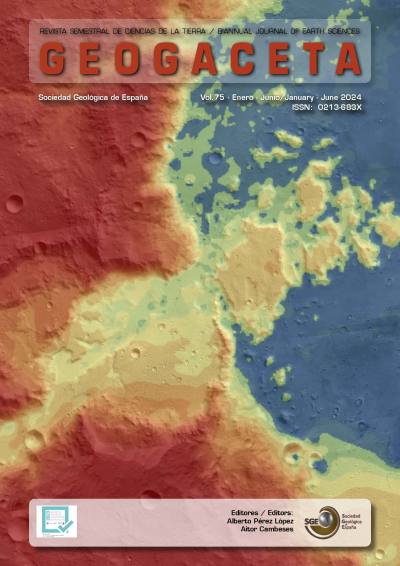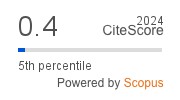The Oligocene–Miocene transition climate recorded in a lacustrine sequence, Ebro Basin: preliminary insights
DOI:
https://doi.org/10.55407/geogaceta100684Keywords:
Oligocene–Miocene transition, lacustrine and palustrine carbonates, paleoclimate, δ13C and δ18O, NE IberiaAbstract
The climate evolution across the Oligocene–Miocene transition has been studied through a 23.5 to 22 Ma succession in the eastern Ebro Basin, dated by magnetostratigraphy. The study is based on the δ13C and δ18O composition coupled with sedimentological analysis of a dominantly lacustrine and palustrine carbonate succession, focusing on the limestone facies. The deposits formed in alluvial plain, saline mud flat, and carbonate lacustrine and palustrine depositional environments. Changes in lake water level and hydrodynamics, and biological processes triggered the formation of distinct carbonate facies, causing isotopic differences among them. The isotopic variations likely reflect changes in the precipitation/evaporation ratio and temperature in the Ebro Basin that might be the regional record of the Mi-1 Glaciation. A change in variability in δ13C and δ18O and an inflection in δ13C mark the Oligocene–Miocene boundary (23.03 Ma). The decrease in δ13C and δ18O variability may correspond to steadier depositional, climatic and hydrological conditions through time.
References
Alonso-Zarza, A.M. (2003). Earth-Science Reviews 60, 261-298. https://doi.org/10.1016/S0012-8252(02)00106-X
Arenas, C. y Pardo, G. (1999). Palaeogeography, Palaeoclimatology, Palaeoecology 151, 127-148. https://doi.org/10.1016/S0031-0182(99)00025-5
Arenas, C., Casanova, J. y Pardo, G. (1997). Palaeogeography 128, 133-155. https://doi.org/10.1016/S0031-0182(96)00052-1
Barberà, X., Cabrera, L., Marzo, M., Parés, J.M. y Agustí, J. (2001). Planetary Science Letters 187, 1-16. https://doi.org/10.1016/S0012-821X(01)00270-9
Cabrera, L., Colombo, F. y Robles, S. (1985). 6th European Reg.Meeting IAS. Exc. Guidebook, 10, 393-492.
Leng, M.J. y Marshall, J.D. (2004). Quaternary Science Reviews 23, 811-831. https://doi.org/10.1016/j.quascirev.2003.06.012
Luzón, A. (1994). Los materiales del tránsito Oligoceno-Mioceno del sector centro- oriental de la Depresión del Ebro. Análisis estratigráfico e interpretación evolutiva. Degree Thesis Univ. of Zaragoza, 259 pp.
Muñoz, A., Arenas, C., González, A., Luzón, A., Pardo, G., Pérez, A. y Villena, J. (2002). In: The Geology of Spain (Gibbons, W. and Moreno, T. Eds.). The Geological Society, London, 301-309.
Osácar, M.C., Arenas, C., Vázquez-Úrbez, M, Sancho, C., Auqué, L.F. y Pardo, G. (2013). Journal of Sedimentary Research 83 (4), 309-322.
Pardo, G., Arenas, C., González, A., Luzón, A., Muñoz, A., Pérez, A., Pérez-Rivarés, F.J., Vázquez-Úrbez, M. y Villena, J. (2004). En: Geología de España (Vera, J.A. Ed.). SGE- IGME, Madrid, 533-543.
Platt, N.H. (1989). Sedimentology 36, 665- 684. https://doi.org/10.1111/j.1365-3091.1989.tb02092.x
Valero, L., Garcés, M., Cabrera, L., Costa, E., y Sáez, A. (2014). Earth and Planetary Science Letters 408, 183-193. https://doi.org/10.1016/j.epsl.2014.10.007
Zachos, J., Pagani, M., Sloan, L., Thomas, E. y Billups, K. (2001). Science 292, 686- 693. https://doi.org/10.1126/science.1059412
Downloads
Published
How to Cite
Issue
Section
License
Copyright (c) 2024 Concha Arenas Abad, Lluís Cabrera Pérez, Mª Cinta Osácar Soriano, Luis Valero Valero, Javier Pérez Rivarés, Joaquín Bastida Cuairán, Miguel Garcés Crespo, Luis Auqué Sanz, Andres Gil Imaz, María José Gimeno Serrano

This work is licensed under a Creative Commons Attribution-NonCommercial-ShareAlike 4.0 International License.
Until the year 2023 the author assigned the copyright to the Sociedad Geológica de España, but from 2024 the author retains the copyright and grants the Sociedad Geológica de España the right of first publication and non-exclusive distribution of each article in all current or future media, while transferring, also non-exclusively, the commercial rights for the distribution of the printed version of Geogaceta. On the other hand, the articles, from the year 2023, are available simultaneously with their publication, under the Creative Commons CC BY-NC-SA 4.0 license, which allows copying, transforming the work, but if any transformation is distributed, the new work must be distributed under the same license, and never for commercial purposes, while acknowledging the authorship and original publication in GEOGACETA, so that the only role of copyright is to give authors control over the integrity of their works and the right to be properly acknowledged and cited.









